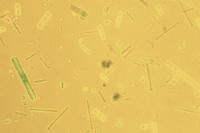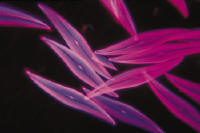|
The major parts of a
compound microscope include the eyepiece, objective, and stage for both
reflective and transmitting light microscopes. The transmitted light
microscope also needs to consider illumination which aids into seeing the
object clear.
Eyepieces are used
for magnification. Microscopes either are monocular, meaning that it has
only one eyepiece, binocular (two eyepieces) or triocular (two for eyes,
and one for camera). Sometimes a binocular reflected light microscope are
referred to it as stereoscopic which only means that you are using two
oculars to see depth. The eyepieces are usually marked with a number.
For example, “15.5 mm” relates to eye relief or the distance between the
eye and the lens.
Objectives provide
the resolution power of the microscope, which increases the detail. A
reflecting light microscope (dissecting microscope) has a lower resolving
power than a transmitted light microscope. However a reflecting
microscope has a better depth of field and
ideal for dissecting or looking at larger objects that cannot be made into
a slide.
In transmitting light
microscopes the illumination system is very important. The system
includes the light source, condenser, and iris. A
condenser is usually a combination of lenses that gathers and
concentrates light in a specified direction, under the stage. The iris
controls the intensity of the light that goes into the condenser. The
light source is a variety of bulbs that create just the right kind of
light with little heat.
|

Excessive light makes picture
look "washed out"
|

Types of illumination can
bring out details |
|